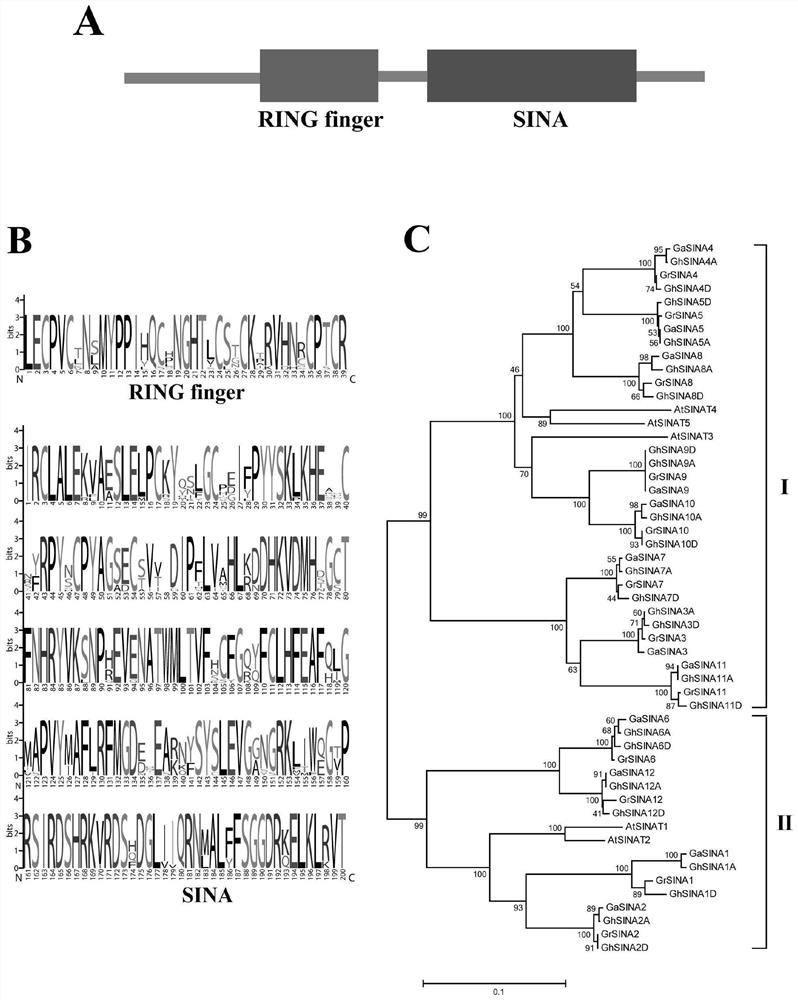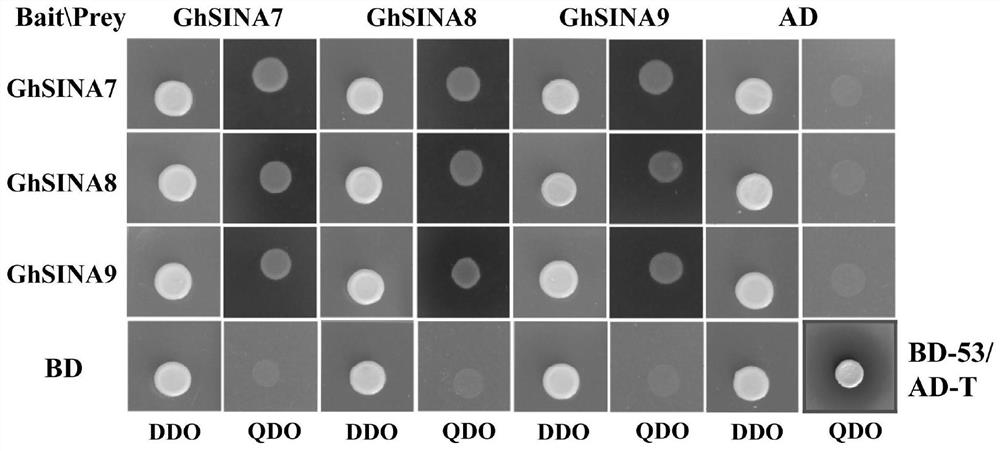Application of Gene ghsinas in Controlling Cotton Verticillium Wilt
A cotton Verticillium wilt and anti-Verticillium wilt technology, applied in the field of plant disease control, can solve problems such as unknown functions and applications
- Summary
- Abstract
- Description
- Claims
- Application Information
AI Technical Summary
Problems solved by technology
Method used
Image
Examples
Embodiment 1
[0092] Bioinformatics Analysis
[0093] In order to study the role of cotton SINA ubiquitin ligases, a total of 12 Asian cotton, 12 Raymond cotton and 24 upland cotton SINA genes were identified in the cotton genome database. Among them, 3 cotton varieties of Upland cotton, Asian cotton and Raymond cotton were obtained from the CottonFGD database (http: / / www.cottonfgd.org / ). Afterwards, the upland cotton SINA gene was cloned, and the coding sequence of GhSINA8 obtained by sequencing was modified on the basis of its initial annotation. These SINAs encode two typical conserved domains, a RING finger domain (at the amino-terminus)) and a SINA domain (at the carboxy-terminus) ( figure 1 A)). In order to study the sequence of the SINA homology domain of upland cotton and the conserved frequency of each residue, the sequence alignment was performed and the sequence characteristics of the SINA protein were obtained, such as figure 1 As shown in B, the sequence identification map s...
Embodiment 2
[0097] Expression analysis of GhSINA gene in response to Verticillium wilt
[0098] 24 hours after GFP-labeled Verticillium dahliae infected upland cotton, it was detected that the conidia on the roots of cotton seedlings had germinated and the hyphae of Verticillium dahliae had grown and extended. In order to determine whether the expression levels of GhSINA genes changed 24 hours after Verticillium dahliae infection, their transcription levels in the roots of an upland cotton resistant variety (Zhongzhimian No. 2) were studied, and the primers involved are shown in Table 1. Among them, GhSINA7, GhSINA8, and GhSINA9 exist in subgroup A chromosome and subgroup D chromosome respectively, but the sequences of their homologous gene pairs are highly similar, and it is difficult to distinguish these homologous gene pairs by real-time fluorescent PCR (qRT-PCR). , so they are amplified together. figure 2 The expression level of SINA gene in Zhimian No. 2, a resistant variety, was i...
Embodiment 3
[0103] 1. Yeast two-hybrid experiment
[0104] Yeast two-hybrid screening was constructed according to the instructions of the Matchmaker Gold yeast two-hybrid system (Clontech, Palo Alto, CA, USA). The full-length cDNAs of GhSINAs (see Table 2 for specific primers) were cloned into the bait vector pGBDK7 and the prey vector pGADT7, respectively. The constructed recombinant plasmid was co-transformed into yeast Y2HGold, and cultured on SD / -Leu / -TrpDO (DDO) medium at 30°C for 3 days. Pick independent colonies of the same size and transfer them to SD / -Leu / Trp / -Ade / -His DO (QDO) medium containing X-α-Gal (Clontech), and evaluate the GhSINA protein by whether the colonies turn blue. interaction between.
[0105] Table 2 GhSINAs primers for different vectors
[0106]
[0107]SINA proteins perform biological functions by forming homodimers or heterodimers. In order to determine whether these three candidate GhSINAs proteins have the ability to form homo- or hetero-dimers, the...
PUM
 Login to View More
Login to View More Abstract
Description
Claims
Application Information
 Login to View More
Login to View More - R&D
- Intellectual Property
- Life Sciences
- Materials
- Tech Scout
- Unparalleled Data Quality
- Higher Quality Content
- 60% Fewer Hallucinations
Browse by: Latest US Patents, China's latest patents, Technical Efficacy Thesaurus, Application Domain, Technology Topic, Popular Technical Reports.
© 2025 PatSnap. All rights reserved.Legal|Privacy policy|Modern Slavery Act Transparency Statement|Sitemap|About US| Contact US: help@patsnap.com



